同济大学:《货币金融学》课程教学资源(试卷习题)Answers for Test Sample(参考答案)Chapter 1-10
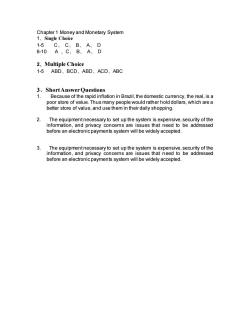
Chapter 1 Money and Monetary System 1、Single Choice 1-5C、C、B、A、D 6-10A、C、B、A、D 2、Multiple Choice 1-5ABD、BCD、ABD、ACD、ABC 3 ShortAnswer Questions 1.Because of the rapid inflation in Brazil,the domestic currency,the real,is a poor store of value.Thus many people would rather hold dollars,which are a better store of value,and use them in their daily shopping. 2.The equipmentnecessary to set up the system is expensive,security of the information,and privacy concemns are issues that need to be addressed before an electronic payments system will be widely accepted. 3.The equipmentnecessary to set up the system is expensive,security of the information,and privacy concerns are issues that need to be addressed before an electronic payments system will be widely accepted
Chapter 1 Money and Monetary System 1、Single Choice 1-5 C、 C、 B、 A、 D 6-10 A 、C、 B、 A、 D 2、Multiple Choice 1-5 ABD、BCD、ABD、ACD、ABC 3、Short Answer Questions 1. Because of the rapid inflation in Brazil, the domestic currency, the real, is a poor store of value. Thus many people would rather hold dollars, which are a better store of value, and use them in their daily shopping. 2. The equipment necessary to set up the system is expensive, security of the information, and privacy concerns are issues that need to be addressed before an electronic payments system will be widely accepted. 3. The equipment necessary to set up the system is expensive, security of the information, and privacy concerns are issues that need to be addressed before an electronic payments system will be widely accepted
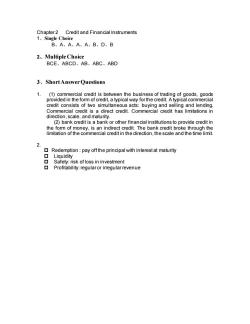
Chapter 2 Credit and Financial Instruments 1、Single Choice B、A、A、A、A、B、D、B 2、Multiple Choice BCE、ABCD、AB、ABC、ABD 3,Short Answer Questions 1.(1)commercial credit is between the business of trading of goods,goods provided in the form of credit,a typical way for the credit.A typical commercial credit consists of two simultaneous acts:buying and selling and lending. Commercial credit is a direct credit.Commercial credit has limitations in direction,scale,and maturity. (2)bank credit is a bank or other financial institutions to provide credit in the form of money,is an indirect credit.The bank credit broke through the limitation of the commercial credit in the direction,the scale and the time limit. Redemption:pay off the principal with interest at maturity ▣Liquidity Safety:risk of loss in investment Profitability:regular or irregular revenue
Chapter 2 Credit and Financial Instruments 1、Single Choice B、A、A、A、A、B、D、B 2、Multiple Choice BCE、ABCD、AB、ABC、ABD 3、Short Answer Questions 1. (1) commercial credit is between the business of trading of goods, goods provided in the form of credit, a typical way for the credit. A typical commercial credit consists of two simultaneous acts: buying and selling and lending. Commercial credit is a direct credit. Commercial credit has limitations in direction, scale, and maturity. (2) bank credit is a bank or other financial institutions to provide credit in the form of money, is an indirect credit. The bank credit broke through the limitation of the commercial credit in the direction, the scale and the time limit. 2. Redemption : pay off the principal with interest at maturity Liquidity Safety: risk of loss in investment Profitability: regular or irregular revenue
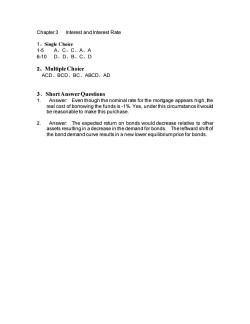
Chapter 3 Interest and Interest Rate 1、Single Choice 1-5A、C、C、A、A 6-10D、D、B、C、D 2、Multiple Choice ACD、BCD、BC、ABCD、AD 3 ShortAnswer Questions 1.Answer:Even though the nominal rate for the mortgage appears high,the real cost of borrowing the funds is-1%.Yes,under this circumstance it would be reasonable to make this purchase. 2.Answer:The expected return on bonds would decrease relative to other assets resulting in a decrease in the demand for bonds.The leftward shift of the bond demand curve results in a new lower equilibrium price for bonds
Chapter 3 Interest and Interest Rate 1、Single Choice 1-5 A、C、C、A、A 6-10 D、D、B、C、D 2、Multiple Choice ACD、BCD、BC、ABCD、AD 3、Short Answer Questions 1. Answer: Even though the nominal rate for the mortgage appears high, the real cost of borrowing the funds is -1%. Yes, under this circumstance it would be reasonable to make this purchase. 2. Answer: The expected return on bonds would decrease relative to other assets resulting in a decrease in the demand for bonds. The leftward shift of the bond demand curve results in a new lower equilibrium price for bonds
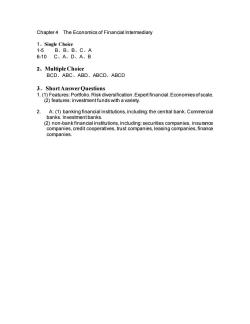
Chapter 4 The Economics of Financial Intermediary 1、Single Choice 1-5B、B、B、C、A 6-10C、A、D、A、B 2、Multiple Choice BCD、ABC、ABD、ABCD、ABCD 3.ShortAnswer Questions 1.(1)Features:Portfolio.Risk diversification.Expert financial.Economies of scale. (2)features:investmentfunds with a variety. 2.A:(1)banking financial institutions,including:the central bank.Commercial banks.Investment banks. (2)non-bank financial institutions,including:securities companies,insurance companies,credit cooperatives,trust companies,leasing companies,finance companies
Chapter 4 The Economics of Financial Intermediary 1、Single Choice 1-5 B、B、B、C、A 6-10 C、A、D、A、B 2、Multiple Choice BCD、ABC、ABD、ABCD、ABCD 3、Short Answer Questions 1. (1) Features: Portfolio. Risk diversification. Expert financial. Economies of scale. (2) features: investment funds with a variety. 2. A: (1) banking financial institutions, including: the central bank. Commercial banks. Investment banks. (2) non-bank financial institutions, including: securities companies, insurance companies, credit cooperatives, trust companies, leasing companies, finance companies
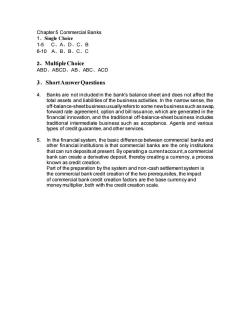
Chapter 5 Commercial Banks 1、Single Choice 1-5C、A、D、C、B 6-10A、B、B、C、C 2、Multiple Choice ABD、ABCD、AB、ABC、ACD 3,Short Answer Questions 4.Banks are not included in the bank's balance sheet and does not affect the total assets and liabilities of the business activities.In the narrow sense,the off-balance-sheetbusiness usually refers to some new business such as swap, forward rate agreement,option and bill issuance,which are generated in the financial innovation,and the traditional off-balance-sheet business includes traditional intermediate business such as acceptance.Agents and various types of credit guarantee,and other services. 5.In the financial system,the basic difference between commercial banks and other financial institutions is that commercial banks are the only institutions that can run deposits at present.By operating a currentaccount,a commercial bank can create a derivative deposit,thereby creating a currency,a process known as credit creation. Part of the preparation by the system and non-cash settlement system is the commercial bank credit creation of the two prerequisites,the impact of commercial bank credit creation factors are the base currency and money multiplier,both with the credit creation scale
Chapter 5 Commercial Banks 1、Single Choice 1-5 C、A、D、C、B 6-10 A、B、B、C、C 2、Multiple Choice ABD、ABCD、AB、ABC、ACD 3、Short Answer Questions 4. Banks are not included in the bank's balance sheet and does not affect the total assets and liabilities of the business activities. In the narrow sense, the off-balance-sheet business usually refers to some new business such as swap, forward rate agreement, option and bill issuance, which are generated in the financial innovation, and the traditional off-balance-sheet business includes traditional intermediate business such as acceptance. Agents and various types of credit guarantee, and other services. 5. In the financial system, the basic difference between commercial banks and other financial institutions is that commercial banks are the only institutions that can run deposits at present. By operating a current account, a commercial bank can create a derivative deposit, thereby creating a currency, a process known as credit creation. Part of the preparation by the system and non-cash settlement system is the commercial bank credit creation of the two prerequisites, the impact of commercial bank credit creation factors are the base currency and money multiplier, both with the credit creation scale
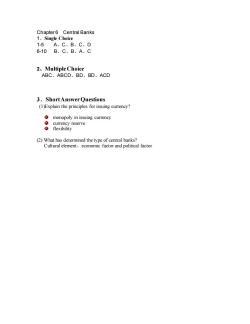
Chapter6 Central Banks 1、Single Choice 1-5A、C、B、C、D 6-10B、C、B、A、C 2、Multiple Choice ABC、ABCD、BD、BD、ACD 3.ShortAnswer Questions (1)Explain the principles for issuing currency? monopoly in issuing currency ●currency reserve ●flexibility (2)What has determined the type of central banks? Cultural element,economic factor and political factor
Chapter 6 Central Banks 1、Single Choice 1-5 A、C、B、C、D 6-10 B、C、B、A、C 2、Multiple Choice ABC、ABCD、BD、BD、ACD 3、Short Answer Questions (1)Explain the principles for issuing currency? monopoly in issuing currency currency reserve flexibility (2) What has determined the type of central banks? Cultural element、economic factor and political factor
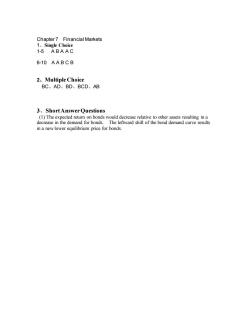
Chapter 7 Financial Markets 1、Single Choice 1-5 ABAAC 6-10 AABCB 2、Multiple Choice BC、AD、BD、BCD、AB 3.Short Answer Questions (1)The expected return on bonds would decrease relative to other assets resulting in a decrease in the demand for bonds.The leftward shift of the bond demand curve results in a new lower equilibrium price for bonds
Chapter 7 Financial Markets 1、Single Choice 1-5 A B A A C 6-10 A A B C B 2、Multiple Choice BC、AD、BD、BCD、AB 3、Short Answer Questions (1) The expected return on bonds would decrease relative to other assets resulting in a decrease in the demand for bonds. The leftward shift of the bond demand curve results in a new lower equilibrium price for bonds
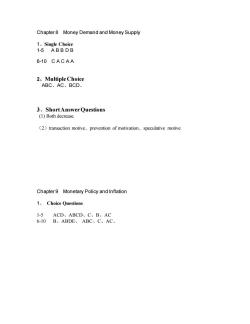
Chapter 8 Money Demand and Money Supply 1、Single Choice 1-5 ABBDB 6-10 CACAA 2、Multiple Choice ABC、AC、BCD、 3,Short Answer Questions (1)Both decrease. (2)transaction motive,prevention of motivation,speculative motive Chapter 9 Monetary Policy and Inflation 1、Choice Questions 1-5ACD、ABCD、C、B、AC 6-10B、ABDE、ABC、C、AC
Chapter 8 Money Demand and Money Supply 1、Single Choice 1-5 A B B D B 6-10 C A C A A 2、Multiple Choice ABC、AC、BCD、 3、Short Answer Questions (1) Both decrease. (2)transaction motive、prevention of motivation、speculative motive Chapter 9 Monetary Policy and Inflation 1、 Choice Questions 1-5 ACD、ABCD、C、B、AC 6-10 B、ABDE、 ABC、C、AC
按次数下载不扣除下载券;
注册用户24小时内重复下载只扣除一次;
顺序:VIP每日次数-->可用次数-->下载券;
- 同济大学:《货币金融学》课程教学资源(试卷习题)Chapter 9 Money and Inflation.docx
- 同济大学:《货币金融学》课程教学资源(试卷习题)Chapter 8 Money Supply and Money Demand.docx
- 同济大学:《货币金融学》课程教学资源(试卷习题)Chapter 7 Financial Markets.docx
- 同济大学:《货币金融学》课程教学资源(试卷习题)Chapter 6 Central Banks.docx
- 同济大学:《货币金融学》课程教学资源(试卷习题)Chapter 5 Commercial Banks.docx
- 同济大学:《货币金融学》课程教学资源(试卷习题)Chapter 4 The Economics of Financial Intermediary.docx
- 同济大学:《货币金融学》课程教学资源(试卷习题)Chapter 3 Interest and Interest Rate.docx
- 同济大学:《货币金融学》课程教学资源(试卷习题)Chapter 2 Credit and Financial Instruments.docx
- 同济大学:《货币金融学》课程教学资源(试卷习题)Chapter 1 Money and Monetary System.docx
- 同济大学:《货币金融学》课程教学资源(大纲教案)教学大纲 The Economics of Money and Banking.pdf
- 吉林大学:《财政学》课程教学资源(试卷习题)远程教育考试样卷(无答案).doc
- 吉林大学:《经济法》课程电子教案(PPT教学课件,共十三章,授课对象:远程教育,授课教师:孙凤英).ppt
- 《财务管理》课程教学资源(专项报告)南宁市宾阳县生猪现代农业产业园实施方案(简版).pdf
- 《财务管理》课程教学资源(专项报告)存栏1120头商品猪养殖小区可行性研究报告(简版).pdf
- 《财务管理》课程教学资源(专项报告)存栏2000头祖代原种猪场可行性研究报告(简版).pdf
- 《财务管理》课程教学资源(专项报告)存栏3000头曾祖代原种猪场环保生态养殖综合开发项目可研报告(简版).pdf
- 《财务管理》课程教学资源(专项报告)存栏5000头基础母猪现代化生猪养殖场可行性研究报告(简版).pdf
- 《财务管理》课程教学资源(专项报告)山西灵空山国家级自然保护区2016年林业国家级自然保护区补助资金建设项目可行性研究报告(简版).pdf
- 《财务管理》课程教学资源(专项报告)森林康养度假建设项目可行性研究报告(简版).pdf
- 山西农业大学:《财务管理》课程教学资源(试卷习题)财务管理期末考试模拟题三及答案.pdf
- 同济大学:《货币金融学》课程电子教案(课件讲稿)Chapter 1 Introduction(负责人:郭英).pdf
- 同济大学:《货币金融学》课程电子教案(课件讲稿)Chapter 2 Money and Monetary System.pdf
- 同济大学:《货币金融学》课程电子教案(课件讲稿)Chapter 3 Credit and Financial Instrument.pdf
- 同济大学:《货币金融学》课程电子教案(课件讲稿)Chapter 4 Interest and Interest Rate.pdf
- 同济大学:《货币金融学》课程电子教案(课件讲稿)Chapter 5 Financial Institutions.pdf
- 同济大学:《货币金融学》课程电子教案(课件讲稿)Chapter 6 Commercial Banks.pdf
- 同济大学:《货币金融学》课程电子教案(课件讲稿)Chapter 7 Central Banks.pdf
- 同济大学:《货币金融学》课程电子教案(课件讲稿)Chapter 8 Financial Markets.pdf
- 同济大学:《货币金融学》课程电子教案(课件讲稿)Chapter 10 Monetary Policy.pdf
- 同济大学:《货币金融学》课程电子教案(课件讲稿)Chapter 9 Money Demand and Money Supply.pdf
- 同济大学:《货币金融学》课程电子教案(课件讲稿)Chapter 11 Inflation and Deflation.pdf
- 吉林大学:《会计学》课程电子教案(PPT课件)第一章 绪论(负责人:孙烨).ppt
- 吉林大学:《会计学》课程电子教案(PPT课件)第二章 帐户与复式记帐.ppt
- 吉林大学:《会计学》课程电子教案(PPT课件)第三章 分录与记帐.ppt
- 吉林大学:《会计学》课程电子教案(PPT课件)第四章 试算与调整.ppt
- 吉林大学:《会计学》课程电子教案(PPT课件)第十章 无形资产与其他资产.ppt
- 吉林大学:《会计学》课程电子教案(PPT课件)第十一章 负债.ppt
- 吉林大学:《会计学》课程电子教案(PPT课件)第十二章 所有者权益.ppt
- 吉林大学:《会计学》课程电子教案(PPT课件)第五章 结帐与编表.ppt
- 吉林大学:《会计学》课程电子教案(PPT课件)第六章 货币资金与应收帐款.ppt
